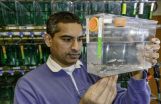(Press-News.org) Stanford, CA— As every gardner knows, nitrogen is crucial for a plant's growth. But nitrogen absorption is inefficient. This means that on the scale of food crops, adding significant levels of nitrogen to the soil through fertilizer presents a number of problems, particularly river and groundwater pollution. As a result, finding a way to improve nitrogen uptake in agricultural products could improve yields and decrease risks to environmental and human health. Nitrogen is primarily taken up from the soil by the roots and assimilated by the plant to become part of DNA, proteins, and many other compounds. Uptake is controlled by a number of factors, including availability, demand, and the plant's energy status. But there is much about the transport proteins involved in the process that isn't understood. New work from Carnegie's Cheng-Hsun Ho and Wolf Frommer developed tools that could help scientists observe the nitrogen-uptake process in real time and could lead to developments that improve agriculture and the environment. It will be published by eLife on March 11 and is already available online.
Frommer had previously developed technology to spy on transport protein activity by using fluorescent tags in a cell's DNA to monitor the structural rearrangements that a transporter undergoes as it moves its target molecule. They tailored this technology to five nitrogen transport targets to monitor the nitrogen uptake and assimilation process. "We engineered these sensors to monitor the activity and regulation of suspected nitrogen transporters in living plant roots, which otherwise are impossible to study," Frommer said. "This suite of tools will vastly improve our understanding of the nitrogen-uptake process and will help to develop increased crop yields and decrease fertilizer-caused pollution."
Their method is applicable to any transporter from any organism, thereby enabling the otherwise exceptionally difficult analysis of transport processes in the tissues of plants and animals.
INFORMATION:
This work was funded by the NSF.
Nitrogen-tracking tools for better crops and less pollution
2014-02-18
ELSE PRESS RELEASES FROM THIS DATE:
Regenerating orthopedic tissues within the human body
2014-02-18
By combining a synthetic scaffolding material with gene delivery techniques, researchers at Duke University are getting closer to being able to generate replacement cartilage where it's needed in the body.
Performing tissue repair with stem cells typically requires applying copious amounts of growth factor proteins -- a task that is very expensive and becomes challenging once the developing material is implanted within a body. In a new study, however, Duke researchers found a way around this limitation by genetically altering the stem cells to make the necessary growth ...
Research of zebrafish neurons may lead to understanding of birth defects like spina bifida
2014-02-18
COLUMBIA, Mo. – The zebrafish, a tropical freshwater fish similar to a minnow and native to the southeastern Himalayan region, is well established as a key tool for researchers studying human diseases, including brain disorders. Using zebrafish, scientists can determine how individual neurons develop, mature and support basic functions like breathing, swallowing and jaw movement. Researchers at the University of Missouri say that learning about neuronal development and maturation in zebrafish could lead to a better understanding of birth defects such as spina bifida in ...
Prison-based education declined during economic downturn, study finds
2014-02-18
State-level spending on prison education programs declined sharply during the economic downturn, with the sharpest drop occurring in states that incarcerate the most prisoners, according to a new RAND Corporation study.
Large states cut spending by an average of 10 percent between the 2009 and 2012 fiscal years, while medium-sized states cut spending by 20 percent, according to the study.
"There has been a dramatic contraction of the prison education system, particularly those programs focused on academic instruction versus vocational training," said Lois Davis, the ...
Miriam Hospital study shows social gaming site effective weight loss tool
2014-02-18
(PROVIDENCE, R.I.) -- Researchers from The Miriam Hospital have found that DietBet, a web-based commercial weight loss program that pairs financial incentives with social influence, delivers significant weight losses. The study and its findings have been published in the current issue of the open access publication JMIR Serious Games.
Tricia Leahey, Ph.D., lead researcher at The Miriam Hospital Weight Control and Diabetes Research Center, sought to examine weight losses associated with the social gaming website and contributing factors to gauge the success of such web-based ...
Rife with hype, exoplanet study needs patience and refinement
2014-02-18
Imagine someone spent months researching new cities to call home using low-resolution images of unidentified skylines. The pictures were taken from several miles away with a camera intended for portraits, and at sunset. From these fuzzy snapshots, that person claims to know the city's air quality, the appearance of its buildings, and how often it rains.
This technique is similar to how scientists often characterize the atmosphere — including the presence of water and oxygen — of planets outside of Earth's solar system, known as exoplanets, according to a review of exoplanet ...
Frequent flyers, bottle gourds crossed the ocean many times
2014-02-18
Bottle gourds traveled the Atlantic Ocean from Africa and were likely domesticated many times in various parts of the New World, according to a team of scientists who studied bottle gourd genetics to show they have an African, not Asian ancestry.
"Beginning in the 1950s we thought that bottle gourds floated across the ocean from Africa," said Logan Kistler, post-doctoral researcher in anthropology, Penn State. "However, a 2005 genetic study of gourds suggested an Asian origin."
Domesticated bottle gourds are ubiquitous around the world in tropical and temperate areas ...
NASA sees Tropical Cyclone 15S form in the Mozambique Channel
2014-02-18
NASA's Aqua satellite passed over Tropical Cyclone 15S as it formed in the Mozambique Channel on Feb. 18 and the AIRS instrument aboard gathered infrared data on its cloud top temperatures and potential.
NASA's Aqua satellite passed over Tropical cyclone 15S on Feb. 18 at 10:53 a.m. EST. The Atmospheric Infrared Sounder or AIRS instrument captured infrared data on the tropical system that showed the highest cloud tops and strongest thunderstorms were in a band that stretched from the east to the south of the center. Cloud top temperatures were near -63F/-52C, indicating ...
Agricultural productivity loss as a result of soil and crop damage from flooding
2014-02-18
URBANA, Ill. – The Cache River Basin, which once drained more than 614,100 acres across six southern Illinois counties, has changed substantively since the ancient Ohio River receded. The basin contains a slow-moving, meandering river; fertile soils and productive farmlands; deep sand and gravel deposits; sloughs and uplands; and one of the most unique and diverse natural habitats in Illinois and the nation.
According to a recent University of Illinois study, the region's agricultural lands dodged a bullet due to the timing of the great flood of April 2011 when the Ohio ...
GW spirituality and health pioneer publishes paper on development of the field
2014-02-18
WASHINGTON (Feb. 18, 2014) — While spirituality played a significant role in health care for centuries, technological advances in the 20th century overshadowed this more human side of medicine. Christina Puchalski, M.D.'94, RESD'97, founder and director of the George Washington University (GW) Institute for Spirituality and Health and professor of medicine at the GW School of Medicine and Health Sciences (SMHS), and co-authors published a commentary in Academic Medicine on the history of spirituality and health, the movement to reclaim medicine's spiritual roots, and the ...
Neuropsychological assessment more efficient than MRI for tracking disease progression
2014-02-18
Amsterdam, NL, February 18, 2014 – Investigators at the University of Amsterdam, The Netherlands, have shown that progression of disease in memory clinic patients can be tracked efficiently with 45 minutes of neuropsychological testing. MRI measures of brain atrophy were shown to be less reliable to pick up changes in the same patients.
This finding has important implications for the design of clinical trials of new anti-Alzheimer drugs. If neuropsychological assessment is used as the outcome measure or "gold standard," fewer patients would be needed to conduct such ...



